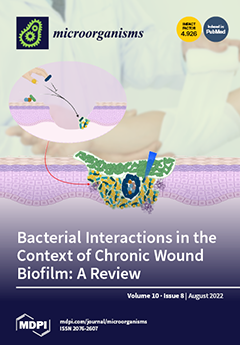Hard ticks (Ixodida: Ixodidae) are medically important ectoparasites that feed on all classes of terrestrial vertebrates. Recently, we molecularly characterized hard ticks and associated
Anaplasma spp. in the northern and central regions of Khyber Pakhtunkhwa (KP), Pakistan; however, this knowledge was missing in the southern regions. This study aimed to investigate tick prevalence, host range, genetic diversity, and molecular survey of
Anaplasma spp. in a wide range of tick species in two distinct physiographic regions of southern KP. A total of 1873 hard ticks were randomly collected from 443/837 hosts (cattle, Asian water buffaloes, horses, goats, sheep, dogs, and camels) in Lakki Marwat, Bannu, and Orakzai districts of KP. Overall, 12 tick species were morphologically identified, among which
Hyalomma dromedarii was the most prevalent species (390/1873, 20.9%), followed by
Hy. anatolicum (294, 15.7%),
Rhipicephalus microplus (262, 14%),
Hy. scupense (207, 11.1%),
R. sanguineus (136, 7.3%),
R. turanicus (121, 6.5%),
Haemaphysalis cornupunctata (107, 5.7%),
R. haemaphysaloides (110, 5.9%),
Ha. montgomeryi (87, 4.6%),
Hy. isaaci (58, 3.1%),
Ha. bispinosa (54, 2.9%), and
Ha. sulcata (47, 2.5%). The extracted DNA from a subset of each tick species was subjected to PCR to amplify
cox1 or
16S rRNA sequences of ticks and
16S rRNA sequences of
Anaplasma spp. The tick
cox1 sequences showed 99–100% identities with the sequences of the same species, whereas
16S rRNA sequences of
R. turanicus,
Ha. montgomeryi and
Ha. sulcata showed 97–100% identities with the corresponding species. The
16S rRNA sequence of
Ha. cornupunctata showed 92% identity with the species from the same subgenus, such as
Ha. punctata. The
16S rRNA sequence of
Anaplasma spp. showed 100% identity with
Anaplasma marginale. Moreover, 54 ticks were found positive for
A. marginale with a total infection rate of 17.2%. The highest infection rate was recorded in
Hy. dromedarii (31.1%) and the lowest in each
R. haemaphysaloides and
R. sanguineus (20%). All the
cox1 or
16S rRNA sequences in phylogenetic trees clustered with the same species, except
Ha. cornupunctata, which clustered with the
Ha. (
Aboimisalis)
punctata. In this study,
Ha. cornupunctata was reported for the first time at the molecular level. The genetic characterization of ixodid ticks and molecular detection of associated
A. marginale will assist in the epidemiological surveillance of these parasites in the region.
Full article






